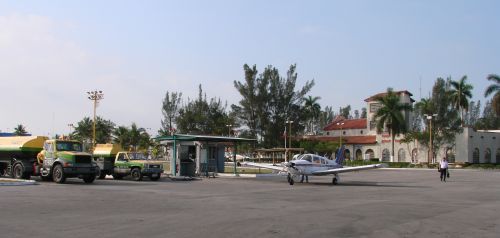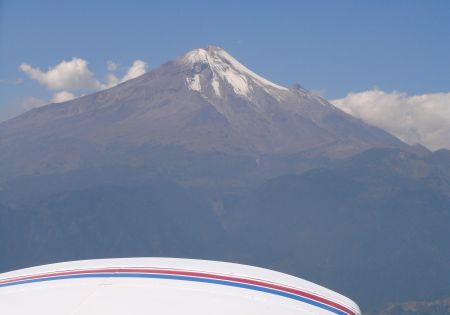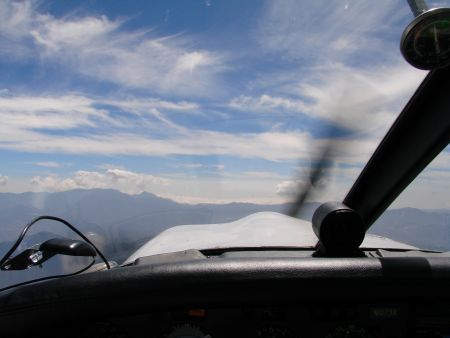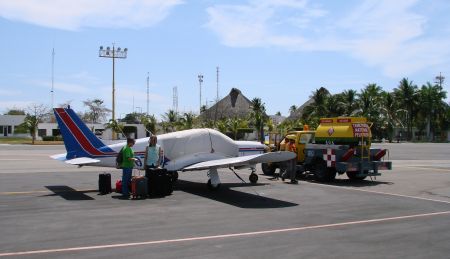
Refueling in Tampico More Photos
|
 Refueling in Tampico More Photos |
We took the hotel shuttle to the airport and visited the main terminal first to use the ATM machine. Since the AOPA information advised that aviation fuel had to be purchased in cash in pesos, we didn't want to run short. There is an ATM machine in the terminal and my wife withdrew 3000 pesos. The cash was dispensed in 100 peso bills. This is unusual for an ATM to dispense cash in small denominations, but welcome since it is often difficult to spend the larger bills. Next her sister attempted to withdraw another 3000 pesos and received the message that she could only withdraw a maximum of 1500 pesos. She did so and received 50-peso bills. Apparently we drained the machine of cash but at least we had lots of small bills for shopping and dining.
We proceeded to the general aviation building to the left of the terminal. I asked for a flight plan to Huatulco. This time the official had me fill out the form myself. I filed VFR direct to Huatulco (using GPS navigation) at an altitude of 7500' and enroute time of 3 hours 45 minutes. I used an online great circle calculator to determine the distance of 461 NM and heading of 166°. I then took the form to another office where I paid the landing/tiedown fee and requested fuel. Then I went to a third office to get the flight plan stamped and then back to the flight plan office where the official retained all but one copy that I took with me.
Even though the fueling was done from a small fuel truck, I was told to taxi to the combustibles area where the truck was parked to get fuel. When we approached the aircraft in its parking spot, the attending soldier came up to speak (in Spanish) with us. He wanted the basic information again and wanted to know where we were going. He was polite and this didn't take long. I taxied to the combustibles area and requested that the tanks be topped off. The attendant asked for a credit card. So you CAN pay with a credit card after all. They accept Mastercard, Visa, and American Express in Tampico. We paid with cash (pesos) instead.
 18,406' high Pico de Orizaba More Photos |
I called the tower and we were instructed to taxi to runway 36. This runway is 4265' long. It didn't look that long to me and had obstacles at the end so about halfway down the runway I added two notches of flaps and took off at a reduced airspeed. We were given a right turnout. The controller requested my enroute heading and told me to report 15 miles south of the airport. I noticed that this airport did have a radar facility and I saw my transponder being polled by apparently a single radar signal, but the controller did not seem to be using it for my flight.
I put the Arrow in a cruise climb and we climbed out of the haze and low scattered clouds. I reported 15 miles out and we were released from the frequency. The direct route threads between areas that are restricted by notam and didn't cross any airport areas until Oaxaca. Thankfully, the winds were not having as great an impact on our progress as the day before. We had an initial groundspeed of 110 knots that improved to 130 knots as the trip continued.
A mountain range appeared as we approached the Veracruz area and I began to climb out of our 7500' cruise altitude. We crossed the first mountain range 231NM into the flight (exactly halfway) at an altitude of 11,500'. The mountains were very pretty with lots of green vegetation and dotted with small homesteads accessed by gravel switchback roads. Some of the drop-offs were quite steep.
At 200 NM into the flight we passed by the 18,406' high Pico de Orizaba volcano, a prominent snow-capped landmark in the State of Puebla.
As we approached Oaxaca, I climbed to 12,500, which is the limit for sustained flight without oxygen. I contacted Oaxaca approach. They asked for my departure and destination points. Oaxaca approach asked me to report crossing the VOR. I replied that my route was taking me 10 miles east of the VOR and they asked me to report passing the station. The Oaxaca airport stands out clearly, even from 15 miles away, as a large cleared rectangle with the single runway in the center. I reported passing the station and was asked to report 20 miles south. On reporting 20 miles south I was given an approach frequency of 118.9 and told to expect runway 27.
 One last ridge to cross (at 13,300') before the descent into Huatulco. More Photos |
Huatulco had an inbound commercial flight on the 332 radial and told me to remain north of that radial and to report crossing the station. My transponder was not being polled by radar, indicating that there was not a radar system in service in the area. I was number 2 for landing and crossed over the airport mid-field as Click Airlines turned final. Winds were gusty but the effects diminished near the runway and the landing was uneventful.
On the Ground in Huatulco
 On the ground in Huatulco. More Photos |
The Huatulco airport has a general aviation area and that is where I went to take care of the paperwork to close the flight plan. The official also wanted to see the aircraft entrance permit, Mexican insurance, and my pilot's license. This was the first time I was required to show my pilot's license. Now that I think of it, no one has asked to see my $105 radio station license yet. As I was filling out the form to close my flight plan, another official came in and stood next to me at the counter. He said, "Capitán". He repeated, "Capitán!" I'm not sure how many times he said that before I realized he was talking to me. He had another form for me to complete that was a pass to allow me to get through security to access to the airplane in the future.
The next flight will be a local flight for taking photos.